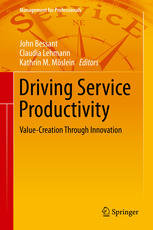

Most ebook files are in PDF format, so you can easily read them using various software such as Foxit Reader or directly on the Google Chrome browser.
Some ebook files are released by publishers in other formats such as .awz, .mobi, .epub, .fb2, etc. You may need to install specific software to read these formats on mobile/PC, such as Calibre.
Please read the tutorial at this link: https://ebookbell.com/faq
We offer FREE conversion to the popular formats you request; however, this may take some time. Therefore, right after payment, please email us, and we will try to provide the service as quickly as possible.
For some exceptional file formats or broken links (if any), please refrain from opening any disputes. Instead, email us first, and we will try to assist within a maximum of 6 hours.
EbookBell Team

5.0
68 reviewsIn a world moving towards services, driving service productivity is a central challenge for leaders and members of all types of organisations: for service businesses there is a clear need to be “productive”, but it is far less clear what this exactly means. In this book, we invite you on a journey that explores the ways, tools and options for driving service productivity. We take an innovator’s perspectives and look at the tricky challenge of service productivity as a landscape of options for designing the future of services.
Case examples, from the airport, hotel, healthcare, and professional service industry, offer insights in the methods used and approaches taken in business practice. Research results provide food for thought and valuable advice on the path towards superior service productivity. Throughout the book we also listen to the views and advices of interviewed experts from academia as well as business practice on how to drive service productivity.
A forecast on how service productivity and service innovation might evolve in the future provides us – and hopefully you as a reader – with the necessary food for thought to develop our own understanding of driving service productivity in different business settings. Overall, this book is not a traditional “academic product” that summarises the views of a few, but a co-created offering that profited enormously from the contributions of so many.